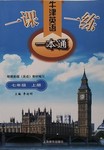
Bernstein had been appointed Assistant Conductor for the New York philharmonic only a few months before that night. Just 25 years old, he was relatively inexperienced. At the last minute, Bernstein was told he was to take Walter’s place, so he didn’t have any time to rehearse(排演). The music he was going to conduct was very difficult. Plus, the concert was going to be broadcast nationally on the radio. Despite all these pressures, Bernstein rose to the occasion and received a standing ovation(长久的鼓掌)at the end of the concert. The event made national headlines, and Bernstein became famous overnight.
Some people feel they do their best under the most stressful circumstances. What was it about Leonard Bernstein that made him do so well in such a difficult situation?
Perhaps Leonard Bernstein did so well because music was his devotion. The son of a man who supplied hairdressing products, Bernstein became interested in music at the age of 10. By the time he was a teenager, he was performing in public. He became a soloist of the Boston Public School Orchestra, and for 13 weeks in 1934, he played classics on the radio.
The underlined word “break” in the first paragraph means “__________”.
A. rest B. chance C. pause D. gap
Which of the following statements is NOT true according to the second paragraph?
A. The concert Bernstein was to play at was going to be broadcast nationally on TV.
B. The music Bernstein was going to conduct was very difficult.
C. When Bernstein was told he was to take Walter’s place, he had no time to practice the performance.
D. Before his performance as a conductor, Leonard Bernstein had little experience.
Leonard Bernstein was successful at the concert because of __________.
A. the wonderful music B. the stress of the circumstances
C. his devotion to music D. Bruno Walter’s absence
From the last paragraph, we can learn that __________.
A. Leonard Bernstein was very clever
B. Leonard Bernstein’s parents worked hard
C. chances are important to a famous person
D. early interest led to Leonard Bernstein’s success
What might be the best title for the text?
A. Leonard Bernstein’s Debut B. Leonard Bernstein’s Life
C. A Young Soloist D. A Great Conductor
 开心蛙状元作业系列答案
开心蛙状元作业系列答案 课时掌控随堂练习系列答案
课时掌控随堂练习系列答案 一课一练一本通系列答案
一课一练一本通系列答案 浙江之星学业水平测试系列答案
浙江之星学业水平测试系列答案科目:高中英语 来源:2010-2011学年山东省兖州市高二下学期期中考试英语卷 题型:阅读理解
Bernstein had been appointed Assistant Conductor for the New York philharmonic only a few months before that night. Just 25 years old, he was relatively inexperienced. At the last minute, Bernstein was told he was to take Walter’s place, so he didn’t have any time to rehearse(排演). The music he was going to conduct was very difficult. Plus, the concert was going to be broadcast nationally on the radio. Despite all these pressures, Bernstein rose to the occasion and received a standing ovation(长久的鼓掌)at the end of the concert. The event made national headlines, and Bernstein became famous overnight.
Some people feel they do their best under the most stressful circumstances. What was it about Leonard Bernstein that made him do so well in such a difficult situation?
Perhaps Leonard Bernstein did so well because music was his devotion. The son of a man who supplied hairdressing products, Bernstein became interested in music at the age of 10. By the time he was a teenager, he was performing in public. He became a soloist of the Boston Public School Orchestra, and for 13 weeks in 1934, he played classics on the radio.
【小题1】The underlined word “break” in the first paragraph means “__________”.
| A.rest | B.chance | C.pause | D.gap |
| A.The concert Bernstein was to play at was going to be broadcast nationally on TV. |
| B.The music Bernstein was going to conduct was very difficult. |
| C.When Bernstein was told he was to take Walter’s place, he had no time to practice the performance. |
| D.Before his performance as a conductor, Leonard Bernstein had little experience. |
| A.the wonderful music | B.the stress of the circumstances |
| C.his devotion to music | D.Bruno Walter’s absence |
| A.Leonard Bernstein was very clever |
| B.Leonard Bernstein’s parents worked hard |
| C.chances are important to a famous person |
| D.early interest led to Leonard Bernstein’s success |
| A.Leonard Bernstein’s Debut | B.Leonard Bernstein’s Life |
| C.A Young Soloist | D.A Great Conductor |
查看答案和解析>>
科目:高中英语 来源:2010届湖北省高考英语总复习练习系列十 题型:阅读理解
At a laboratory in Germany ,volunteers slide into a machine and perform simple tasks, such as deciding whether to add or subtract two numbers , or choosing which of two buttons to press.
They have no idea that scientists in the next room are trying to read their minds-using a brain scan to figure out their intention before it is turned into action.
In the past ,scientists had been able to detect decisions about making physical movements before those movements appeared .But researchers at Berlin's Bernstein Center for Computational Neuroscience claim they have now , for the first time ,identified people's decisions about how they would later do a high-level mental activity-in this case ,adding versus subtracting.
While still in its initial stages ,the techniques may eventually have wide-ranging implications for everything from criminal questioning to airline security checks.
The research,which began in July 2005,has been of limited scope:only 21 people have been tested so far.And the 71 percent accuracy rate is only about 20 percent more successful than random selection.
Still ,the research conducted at the Max Planck Institute for Human Cognitive and Brain Sciences in Leipzig ,about 150 kilometers southwest of Berlin ,has been generating strong interest in the scientific community.
In one study ,participants were told to decide whether to add or subtract two numbers a few seconds before the numbers were flashed on a screen . Meanwhile ,a computer captured images of their brain waves to predict the subject's decision-with one pattern suggesting addition, and another subtraction.
The team ,headed by Haynes ,began its research by trying to identify which part of the mind was storing intentions. They discovered it was found in the prefrontal cortex region by scanning the brain to look for bursts of activity when subjects were given choices.
Then they went about studying which type of patterns were associated with different intentions.
"If you knew which thought signatures to look for ,you could theoretically predict in more detail what people were going to do in the future," said Haynes.
75.Which of the following is true about the experiment at the laboratory?
A.The volunteers are asked to perform very complicated tasks.
B.Everything was explained to the volunteers before the experiment.
C.The volunteers cannot see the scientists while performing the tasks.
D.The volunteers started the experiment by pressing one of the two buttons.
76.Which of the following demonstrates the major breakthrough made by the German scientists?
A.By studying the subjects' brain waves , they know what physical movements they'll make.
B.By studying the subjects' brain waves, they know what mental task they'll perform.
C.By studying criminals' brain waves ,they can help find out whether they are lying or not.
D.By studying passengers' brain waves ,they can help find out who intends to make trouble.
77.In the research which began in July 2005 only______subjects' brains were scanned and the accuracy rate was______.
A.21; 20% B.71;20% C.21;71% D.20;71%
78.The group of scientists in Leiqzig were doing______what the group in Berlin were doing.
A.similar research to B.better research than
C.completely different things from D.a less satisfactory job than
79.The term thought signatures in the last paragraph refers to______.
A.the subjects' intentions B.the subjects' physical movements
C.parts of the human brain D.the human brain wave patterns
80.From the information in the passage, it can be concluded that in the future______.
A.the intentions of people can be predicted accurately
B.it's impossible to predict accurately the intentions of people
C.no one in the world will dare to tell lies to other people
D.everyone will easily know what others are thinking about
查看答案和解析>>
科目:高中英语 来源:2012-2013学年安徽省涡阳四中高二下学期第一次质量检测英语试卷(带解析) 题型:阅读理解
When the Berlin Wall came down in 1989, Leonard Bernstein gave a concert in Berlin, including Beethoven's Ode to Joy, with the word "Joy" changed to "Freedom" in the lyrics sung.The orchestra(管弦乐队)were drawn from both East and West Germany, as well as the United Kingdom, France, the Soviet Union, and the United States.
Freedom was in the air and it was not just for people. The wall between East and West Germany had also kept a large population of wild pigs within the eastern forests of Brandenburg.The wall's falling down made it easier for the big pigs—a very big one can weigh over 300 pounds—to leave the woodlands and walk into the town. Warm winters and easy access to food have helped the population increase. Now about 10,000 wild pigs walk around Berlin.
The nature of the beast has added to the boom(兴旺)."The pigs are intelligent," says Marc Franusch, a spokesman for the Berlin forestry department. "They learn to use the neighborhoods.They get used to people, dogs, and traffic."
The wild pigs tend to travel in small groups and have been found searching rubbish and gardens, feeding their piglets(小猪)in the shadow of parked cars, and crossing busy roads.On average, the animals are involved in one traffic accident every day. And despite the fact that it's illegal, some Berliners have been known to give the pigs food.
Though wild pigs are protected under German law, the city's forestry department is permitted to kill 2,000 of the creatures every year, targeting mostly young adult animals in forests surrounding Berlin. Pigs within city limits are only shot if they make an immediate threat.No humans have yet been seriously wounded by them, but local dogs have been the victims of their tusks. "The forestry department is not aiming to get rid of the pigs," explains Franusch, "but we do have to reduce dangerous situations."
【小题1】The concert in the first paragraph is given to .
| A.celebrate Bernstein's success | B.remind people of fighting for rights |
| C.show the artists' delight of life | D.express people's joy for freedom |
| A.the Berlin Wall | B.adequate food |
| C.their own nature | D.warm winter |
| A.in Berlin people can never kill any wild pig |
| B.it is against law to offer food to wild pigs |
| C.wild pigs each weigh more than three hundred pounds |
| D.traffic accidents are mainly caused by wild pigs in Berlin |
| A.why wild pigs in Berlin enjoy so much freedom |
| B.when wild pigs were united in Berlin |
| C.how wild pigs are living in Berlin |
| D.what damage wild pigs have done to Berliners |
查看答案和解析>>
科目:高中英语 来源:2014届安徽省高二下学期第一次质量检测英语试卷(解析版) 题型:阅读理解
When the Berlin Wall came down in 1989, Leonard Bernstein gave a concert in Berlin, including Beethoven's Ode to Joy, with the word "Joy" changed to "Freedom" in the lyrics sung.The orchestra(管弦乐队)were drawn from both East and West Germany, as well as the United Kingdom, France, the Soviet Union, and the United States.
Freedom was in the air and it was not just for people. The wall between East and West Germany had also kept a large population of wild pigs within the eastern forests of Brandenburg.The wall's falling down made it easier for the big pigs—a very big one can weigh over 300 pounds—to leave the woodlands and walk into the town. Warm winters and easy access to food have helped the population increase. Now about 10,000 wild pigs walk around Berlin.
The nature of the beast has added to the boom(兴旺)."The pigs are intelligent," says Marc Franusch, a spokesman for the Berlin forestry department. "They learn to use the neighborhoods.They get used to people, dogs, and traffic."
The wild pigs tend to travel in small groups and have been found searching rubbish and gardens, feeding their piglets(小猪)in the shadow of parked cars, and crossing busy roads.On average, the animals are involved in one traffic accident every day. And despite the fact that it's illegal, some Berliners have been known to give the pigs food.
Though wild pigs are protected under German law, the city's forestry department is permitted to kill 2,000 of the creatures every year, targeting mostly young adult animals in forests surrounding Berlin. Pigs within city limits are only shot if they make an immediate threat.No humans have yet been seriously wounded by them, but local dogs have been the victims of their tusks. "The forestry department is not aiming to get rid of the pigs," explains Franusch, "but we do have to reduce dangerous situations."
1.The concert in the first paragraph is given to .
A.celebrate Bernstein's success B.remind people of fighting for rights
C.show the artists' delight of life D.express people's joy for freedom
2.The following factors contribute to the boom of wild pigs EXCEPT .
A.the Berlin Wall B.adequate food
C.their own nature D.warm winter
3.From the text we can know that .
A.in Berlin people can never kill any wild pig
B.it is against law to offer food to wild pigs
C.wild pigs each weigh more than three hundred pounds
D.traffic accidents are mainly caused by wild pigs in Berlin
4.The article mainly talks about .
A.why wild pigs in Berlin enjoy so much freedom
B.when wild pigs were united in Berlin
C.how wild pigs are living in Berlin
D.what damage wild pigs have done to Berliners
查看答案和解析>>
科目:高中英语 来源:2010届湖北省高考英语总复习练习系列(十) 题型:阅读理解
At a laboratory in Germany ,volunteers slide into a machine and perform simple tasks, such as deciding whether to add or subtract two numbers , or choosing which of two buttons to press.
They have no idea that scientists in the next room are trying to read their minds-using a brain scan to figure out their intention before it is turned into action.
In the past ,scientists had been able to detect decisions about making physical movements before those movements appeared .But researchers at Berlin's Bernstein Center for Computational Neuroscience claim they have now , for the first time ,identified people's decisions about how they would later do a high-level mental activity-in this case ,adding versus subtracting.
While still in its initial stages ,the techniques may eventually have wide-ranging implications for everything from criminal questioning to airline security checks.
The research,which began in July 2005,has been of limited scope:only 21 people have been tested so far.And the 71 percent accuracy rate is only about 20 percent more successful than random selection.
Still ,the research conducted at the Max Planck Institute for Human Cognitive and Brain Sciences in Leipzig ,about 150 kilometers southwest of Berlin ,has been generating strong interest in the scientific community.
In one study ,participants were told to decide whether to add or subtract two numbers a few seconds before the numbers were flashed on a screen . Meanwhile ,a computer captured images of their brain waves to predict the subject's decision-with one pattern suggesting addition, and another subtraction.
The team ,headed by Haynes ,began its research by trying to identify which part of the mind was storing intentions. They discovered it was found in the prefrontal cortex region by scanning the brain to look for bursts of activity when subjects were given choices.
Then they went about studying which type of patterns were associated with different intentions.
"If you knew which thought signatures to look for ,you could theoretically predict in more detail what people were going to do in the future," said Haynes.
75.Which of the following is true about the experiment at the laboratory?
A.The volunteers are asked to perform very complicated tasks.
B.Everything was explained to the volunteers before the experiment.
C.The volunteers cannot see the scientists while performing the tasks.
D.The volunteers started the experiment by pressing one of the two buttons.
76.Which of the following demonstrates the major breakthrough made by the German scientists?
A.By studying the subjects' brain waves , they know what physical movements they'll make.
B.By studying the subjects' brain waves, they know what mental task they'll perform.
C.By studying criminals' brain waves ,they can help find out whether they are lying or not.
D.By studying passengers' brain waves ,they can help find out who intends to make trouble.
77.In the research which began in July 2005 only______subjects' brains were scanned and the accuracy rate was______.
A.21; 20% B.71;20% C.21;71% D.20;71%
78.The group of scientists in Leiqzig were doing______what the group in Berlin were doing.
A.similar research to B.better research than
C.completely different things from D.a less satisfactory job than
79.The term thought signatures in the last paragraph refers to______.
A.the subjects' intentions B.the subjects' physical movements
C.parts of the human brain D.the human brain wave patterns
80.From the information in the passage, it can be concluded that in the future______.
A.the intentions of people can be predicted accurately
B.it's impossible to predict accurately the intentions of people
C.no one in the world will dare to tell lies to other people
D.everyone will easily know what others are thinking about
查看答案和解析>>
湖北省互联网违法和不良信息举报平台 | 网上有害信息举报专区 | 电信诈骗举报专区 | 涉历史虚无主义有害信息举报专区 | 涉企侵权举报专区
违法和不良信息举报电话:027-86699610 举报邮箱:58377363@163.com